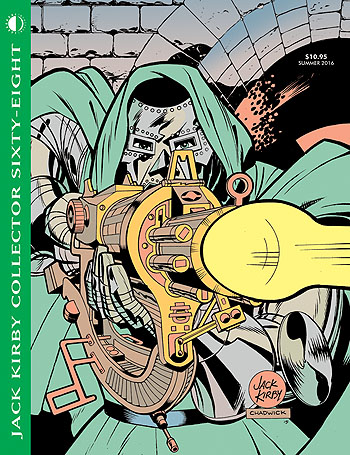Black Panther gets a lot of attention as the first mainstream Black superhero. He's been getting even more attention the past few years thanks to the Black Panther movie. I think, in part, because of Panther's debut in the comics, it's often overlooked that Jack Kirby introduced Wyatt Wingfoot in Fantastic Four a mere two issues earlier, at the tail end of the Galactus Trilogy. Wyatt perhaps never got the same treatment as T'Challa, but it's a significant milestone, I think.
There were, of course, other Native Americans depicted in comics before Wyatt. Some even titled their own books. And, as noted in the panel I'm including here, Wyatt isn't super-powered. (As far as I know, he's never been given super-powers. Even temporarily.) But that's part of what makes him that much more impressive a character. Here's this ordinary guy, and he befriends one of the most well-known heroes on the planet. (I mean the Marvel version of Earth, mind you.) And in no short order, the two of them are off on an adventure to Wakanda. And then they go globe-trotting, looking for some way to break through the powerful barrier that is keeping the Human Torch from his girlfriend, Crystal. Wyatt is not only able to roll with all of this with ease, but he holds his own very well, getting FF and the Torch in particular out of trouble more than a couple times.
Furthermore, Wyatt eschews a lot of the pretty standard "Indian" stereotypes. He's very intelligent and rational, and not especially spiritual. While he's built like a brickhouse, he generally doesn't take much to athletic displays. Although that Tomazooma story a little later is unfortunately rife with stereotypes, Wyatt doesn't really fall prey to them. He's always shown as almost a good-two-shoes hero, not unlike Roy Crane's Captain Easy. The main difference is that Wyatt's heroism is less noticeable when he's always surrounded by superheroes.
I think that speaks a lot to Jack Kirby's thinking. Both Wyatt and T'Challa debuted in 1966, right in the heart of the Civil Rights movement. T'Challa's appearance makes a lot of sense in that context. Jack was obviously seeing various Civil Rights items on the news and in papers, and he later said that he realized that he hadn't been drawing Black characters in his stories, even though he himself grew up alongside many of them in the Lower East Side of Manhattan. But Jack didn't limit his thoughts to Black people.
He was seeing these issues, and realized that many races were not very well represented in comics, including Native Americans. Despite the Civil Rights movement not focusing on Native Americans, Jack made the connection and added Wyatt while he and Stan Lee ironed out some details of Black Panther. (The Jack Kirby Collector #68 featured a column by me where I talk about Black Panther's visual origins -- it's more than that one drawing of Coal Tiger you may have seen!)
It's a pity that Jack experienced a pretty high degree of dismissiveness soon after, as he began keeping more and more of his ideas to himself until he got himself set up over at DC a few years later. He could've forged a lot more ground in the depictions of minority characters had he continued to turn his character ideas over to Marvel. While he still did some of that later, the height of the Civil Rights movement had passed by then and the ideas he had held on to didn't carry the same weight.
But how many other creators were doing that kind of hard work in the mid-1960s? Yeah, maybe Wyatt Wingfoot wasn't then and never became a headliner in the way Black Panther has, but that he exists is still a significant achievement in the world of comics. Who else was putting Native American characters as central protagonists in their biggest selling books? For that matter, who's even doing that today?
In Praise of Wyatt Wingfoot
By Sean Kleefeld | Monday, August 30, 2021
Leave a Comment








0 comments:
Post a Comment